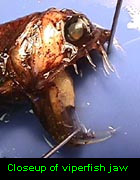Chauliodus sloani habitats a unique environment; therefore, it has many unique adaptations that allow it to thrive. C.. sloani swims using its fins, and uses light-sensing organs to sense and react to environmental stimuli.
Photophores: Many viperfishes have light-producing organs called photophores alongside its body and on the tip of its dorsal fin. C. sloani uses its photophores for capturing prey. C. sloani has the ability to flash its photophores, acting as a lure for smaller fish. These photophores are also believed to be used for communication between viperfishes. There at least 30 distinct light-emitting chemical systems in these photophores! Perhaps the most interesting fact about photophores is that the light emitted is red light, which cannot be seen by other organisms. Because of this, C. sloani can see prey and attack, while the prey cannot see the light emitted!
Mouth: C. sloani has a large mouth, with the lower jaw being much longer than the upper. The upper jaw has four large fangs on each side. The lower jaw has large, sharp, curved teeth used to stab at prey. The teeth are so long, in fact, that they come very close to stabbing the Viperfish in the eye! The curved teeth also prevent the prey from escaping once it is caught. The jaw is hinged, allowing C. sloani to swallow prey much larger than itself.

|
| Permission received by: JD Knight, Sea and Sky Copyright 1998 |
Body Color: C. sloani lives where very little, if any light, reaches. Because of this, C. sloani is often black or dark blue in color, to help camouflage. Some other viperfishes are actually clear, and some have a metallic green color on their back.
Eyes: C. sloani has enlarged eyes used for capturing the most amount of light possible in the depths of the benthic ocean zone.
Stomach: C. sloani can expand its stomach to twice its normal size in order to accommodate large meals.
High Levels of TMAO: TMAO is a chemical in the body that maintains hydration from very salty water.